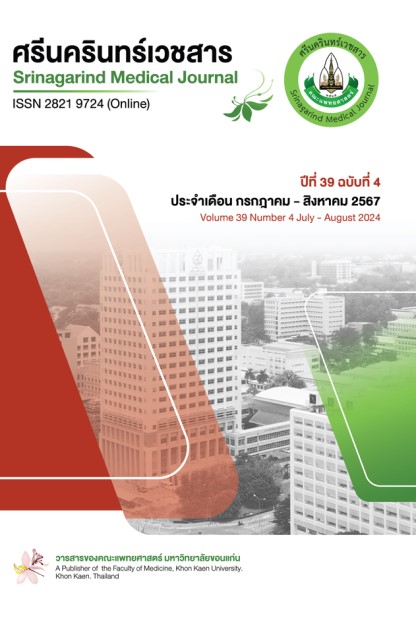Incidence of Respiratory Distress in Term Newborns Presenting within 72 Hours after Birth at Kalasin Hospital
อุบัติการณ์เกิดภาวะหายใจลำบากภายใน 72 ชั่วโมงแรกหลังเกิดในทารกแรกเกิดครบกำหนดที่คลอดในโรงพยาบาลกาฬสินธุ์
Keywords:
respiratory distress, term newborn, transient tachypnea of the newborn, congenital pneumoniaAbstract
Background and Objective: Respiratory distress (RD) is one of the most common problems in term newborns who were admitted to special care newborn unit at Kalasin Hospital and it is the main cause of neonatal morbidity and mortality. This study was conducted to find out the incidence, causes, signs and symptoms, type of oxygen administration and maternal history in term newborns with RD within 72 hours after birth at Kalasin Hospital.
Methods: Retrospective descriptive study was conducted during 1st October 2022 to 30th September 2023. Data were reviewed from medical records of 155 term newborns. Data were analyzed using descriptive statistics and analytic statistics.
Results: Incidence of RD was 8.8%. Most of them developed RD within 6 hours after birth (86.5%). Transient tachypnea of the newborn (TTNB) was the most common cause (41.9%) followed by congenital pneumonia (25.8%) and early onset neonatal sepsis (EOS) (19.4%). In terms of signs and symptoms 87.5% had tachypnea, 83.9% had retraction and 13.5% had nasal flaring. Suprasternal retraction statistically significantly increased the outcome of newborns with oxygen saturation (SpO2) < 95% (OR 7.27, p = 0.01). They were given respiratory support which included oxygen head box 63.2%, heated humidified high flow nasal cannula (HHHFNC) 29.7% and invasive respiratory support 3.2%. Most common maternal history is gestational diabetes (GDM) (14.9%), followed by meconium-stained amniotic fluid (MSAF) (16.1%) and pregnancy induced hypertension (PIH) (6.5%).
Conclusion: RD is a common problem in term newborns. TTNB is the most common cause. Additionally, congenital pneumoniae and early onset neonatal sepsis are also common causes. Symptoms often occur within 6 hours after birth. Therefore, surveillance of RD during this period is crucial for prompt diagnosis and appropriate treatment.
References
Warren JB, Anderson JM. Newborn respiratory disorder. Pediatr Rev 2010;31:487-95. doi:10.1542/pir.31.12.487
Edwards MO, Kotecha SJ, Kotecha S. Respiratory distress of the term newborn infant. Paediatr Respirt Rev 2013;14(1):29-36. doi:10.1016/j.prrv.2012.02.002
Kumar A, Bhat B. Epidemiology of respiratory distress of newborns. Indian J Pediatr 1996;63:93-8. doi:10.1007/BF02823875
Hameed NN, AI-Janabi MK, AL-Reda YI. Respiratory distress in full term newborns. Iraqi Postgraduate Med J 2007;6(3):233-9.
Tananya L. Incidence, presentation, risk Factors and causes of respiratory distress in term newborns at Thammasat University Hospital. Thammasat Med J 2020;20(2):130-6.
Pakaphan K. Approach to respiratory distress in neonates. In: Santi P, editor. Practical Approaches for Neonatal Problems. 1. Bangkok: Active print; 2015:167-81.
National Health Security Office. Guideline for medical document audit. Nontaburi: Sahamitr Printing & Publishing; 2019:106-11.
Galarza MG, Sosenko IRS. Abnormalities of the lungs. In: Rudolph CD, Rudolph AM, Lister GE, et al, editors. Rudolph’s Pediatrics. 22nd ed. New York: McGraw Hill; 2011:201-11.
Gardner SL, Enzman-Hines M, Dicky LA. Respiratory disease. In: Gardner SL, Carter BS, Enzman-Hines M, et al, editors. Merenstein & Gardner’s handbook of neonatal intensive care. 7th ed. St.Loise: Mosby Elsevier; 2011:581-677.
Di Fiore JM, Carlo WA. Assessment of neonatal pulmonary function. In: Martin RJ, Fanaroff AA, Walsh MC, editors. Fanaroff and Martin’s neonatal-perinatal medicine: disease of the fetus and infant. 10th ed. Philadelphia: Elsevier Saunders; 2015:1060-73.
Pakamon C. Incidences of neonatal respiratory distress in normal labored full term newborns in health promoting hospital center. Thai J Pediatr 2017;56(4):301-9.
Kumar A, Vishnu Bhat B. Epidemiology of respiratory distress in newborns. Indian J Pediatr 1996;63(1):93-98. doi:10.1007/BF02823875
Simonsen KA, Anderrson-Berry AL, Delair SF, Davies HD. Early-onset neonatal sepsis. Clin Microbiol Rev 2014;27(1):21-47. doi:10.1128/CMR.00031-13
Parkash A, Haider N, Khoso ZA, Shaikh AS. Frequency, cause and outcome of neonates with respiratory distress admitted to neonatal intensive care unit, National Institute of Child Health, Karachi. J Pak Med Assoc 2015;65(7):771-5.
Downloads
Published
How to Cite
Issue
Section
License
Copyright (c) 2024 Srinagarind Medical Journal

This work is licensed under a Creative Commons Attribution-NonCommercial-NoDerivatives 4.0 International License.




